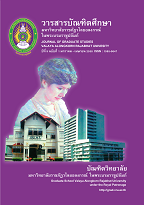สภาพและปัญหาการดำเนินงานระบบการประกันคุณภาพภายในสถานศึกษาขั้นพื้นฐาน สังกัดสำนักงานเขตพื้นที่การศึกษาประถมศึกษานนทบุรี เขต 2 THE STATE AND PROBLEM OF EDUCATION QUALTY ASSURANCE SYSTEM PROCESS
Main Article Content
Abstract
บทคัดย่อ
การวิจัยเรื่อง สภาพและปัญหาการดำเนินงานระบบการประกันคุณภาพภายในสถานศึกษาขั้นพื้นฐาน สังกัดสำนักงานเขตพื้นที่การศึกษาประถมศึกษานนทบุรี เขต 2 มีวัตถุประสงค์เพื่อศึกษาและเปรียบเทียบสภาพปัญหาการดำเนินงานตามระบบการประกันคุณภาพการศึกษาของโรงเรียนในสังกัดสำนักงานเขตพื้นที่การศึกษาประถมศึกษานนทบุรี เขต 2 จำแนกตามขนาดโรงเรียน วุฒิการศึกษา และประสบการณ์ทำงานของผู้บริหารและครูผู้สอน ของโรงเรียนในสังกัดสำนักงานเขตพื้นที่การศึกษาประถมศึกษานนทบุรี เขต 2 จากจำนวนประชากรทั้งสิ้น 780 คน ได้กลุ่มตัวอย่างมาจำนวน 565 คน โดยการสุ่มแบบหลายขั้นตอน เครื่องมือที่ใช้ในการเก็บรวบรวมข้อมูลในครั้งนี้ คือแบบสอบถาม ค่าความเชื่อมั่นทั้งฉบับเท่ากับ 0.98 สถิติที่ใช้ในการวิเคราะห์ข้อมูล ได้แก่ ค่าเฉลี่ย (xˉ) ค่าความเบี่ยงเบนมาตรฐาน (S.D.) สถิติที่ใช้ทดสอบสมมุติฐาน ได้แก่การวิเคราะห์ความแปรปรวนทางเดียว เมื่อพบความแตกต่างอย่างมีนัยสำคัญทางสถิติที่ระดับ .05 จะทดสอบความแตกต่างรายคู่ด้วยวิธีของเชพเฟ่
ผลการวิจัยพบว่า
1. ผลการวิเคราะห์สถานภาพของผู้ตอบแบบสอบถาม พบว่า กลุ่มตัวอย่างส่วนใหญ่ สังกัดสำนักงานเขตพื้นที่การศึกษาประถมศึกษานนทบุรี เขต 2 ขนาดกลาง ร้อยละ 43.41 เป็น เพศหญิง ร้อยละ 66.41 มีการศึกษาระดับปริญญาตรีหรือเทียบเท่า ร้อยละ 61.24 มีตำแหน่งเป็นครูผู้สอน ร้อยละ 98.45 มีประสบการณ์ทำงานน้อยกว่า 10 ปีร้อยละ 52.97
2. ผลการวิเคราะห์สภาพและปัญหาการดำเนินงานระบบการประกันคุณภาพภายในสถานศึกษาขั้นพื้นฐาน สังกัดสำนักงานเขตพื้นที่การศึกษาประถมศึกษานนทบุรี เขต 2 โดยภาพรวมอยู่ในระดับปานกลาง (S.D.=1.39, xˉ=3.37) เมื่อพิจารณาตามรายด้าน พบว่า ด้านการจัดทำแผนพัฒนาการจัดการศึกษาที่มุ่งคุณภาพตามมาตรฐานการศึกษาของสถานศึกษา มีค่าเฉลี่ยสูงสุด อยู่ในระดับ ปานกลาง (S.D.=1.42, xˉ=3.48) และด้านจัดให้มีการติดตามตรวจสอบคุณภาพการศึกษา มีค่าเฉลี่ยต่ำสุด อยู่ในระดับ ปานกลาง (S.D.=1.41, xˉ=3.25)
3. เปรียบเทียบสภาพและปัญหาการดำเนินงานระบบการประกันคุณภาพภายในสถานศึกษาขั้นพื้นฐาน สังกัดสำนักงานเขตพื้นที่การศึกษาประถมศึกษานนทบุรี เขต 2
จำแนกตามขนาดโรงเรียน ตามวุฒิการศึกษา และประสบการณ์ทำงาน พบว่าจำแนกตามขนาดของโรงเรียนโดยภาพรวมและรายด้านไม่มีความแตกต่างกัน แสดงให้เห็นว่า ขนาดของโรงเรียนไม่มีผลต่อสภาพและปัญหาการดำเนินงานระบบการประกันคุณภาพภายในสถานศึกษาขั้นพื้นฐาน สังกัดสำนักงานเขตพื้นที่การศึกษาประถมศึกษานนทบุรี เขต 2
จำแนกตามวุฒิการศึกษา โดยภาพรวมและรายด้านแตกต่างกันอย่างมีนัยสำคัญทางสถิติที่ระดับ .05 แสดงให้เห็นว่า วุฒิการศึกษามีผลต่อสภาพและปัญหาการดำเนินงานระบบการประกันคุณภาพภายในสถานศึกษาขั้นพื้นฐาน สังกัดสำนักงานเขตพื้นที่การศึกษาประถมศึกษานนทบุรี เขต 2
จำแนกประสบการณ์ทำงาน โดยภาพรวมไม่แตกต่างกัน เมื่อพิจารณาตามรายด้าน พบว่า ด้านการดำเนินงานตามแผนพัฒนาการจัดการศึกษาของสถานศึกษา ด้านจัดให้มีการประเมินคุณภาพภายในตามมาตรฐานการศึกษาของสถานศึกษา และด้านจัดให้มีการพัฒนาคุณภาพการศึกษาอย่างต่อเนื่องแตกต่างกันอย่างมีนัยสำคัญทางสถิติที่ระดับ .05 ยกเว้น ด้านการกำหนดมาตรฐานการศึกษาของสถานศึกษา ด้านการจัดทำแผนพัฒนาการจัดการศึกษาที่มุ่งคุณภาพตามมาตรฐานการศึกษาของสถานศึกษา ด้านการจัดระบบบริหารและสารสนเทศ ด้านจัดให้มีการติดตามตรวจสอบคุณภาพการศึกษา และด้านการจัดทำรายงานประจำปีที่เป็นรายงานประเมินคุณภาพภายในไม่แตกต่างกัน
ABSTRACT
Research on “The State and Problem of Education Quality Assurance System Process of Primary Schools under the Office of Nonthaburi Education Service Area 2” aimed to study and compare the state and problem of education quality assurance system process of primary schools under the Office of Nonthaburi Education Service Area 2, differentiated by school size, education, and work experience of administrator and teachers from primary schools under the Office of Nonthaburi Education Service Area 2, a total of 780 people. Samples were 565 persons, surveyed by using the Single-stage Random Sampling. Tool used for data collection was a questionnaire with a reliabiliry of 0.98. Statistics used for data analysis were percentage, mean, and standard deviation. Statistic used to test the hypothesis was One-way analysis of variance. Sheffe’s LSD method will be used when the significant difference in statistic at the level of .05 was found.
The research results were as follows:
1. Analysis result of respondent’s status found was that majority of samples under medium Office of Nonthaburi Education Service area 2 was 43.41%, was a female 66.41%, had a Bachelor’s degree or equivalence 61.24%, had a job position as teacher 98.45%, and had a work experience less than 10 years 52.97%.
2. Analysis result of status and problem of education quality assurance system process of basic education under the Office of Nonthaburi Primary Education Service area 2 as a whole was at a moderate level (S.D.=1.39,xˉ=3.37). Considering each aspect, the plan aiming to improve the quality of education scale of the study of schools had the highest mean in a medium level (S.D.= 1.42, xˉ=3.48), and organization of the tracing of education quality had the lowest mean in a medium level (S.D.=1.41,xˉ=3.25).
3. Comparing the status and problems of the quality assurance system within the basic schools under the office of Nonthaburi education service area 2, differentiated by school size, education, and work experiences found as follows: Differentiating by school’s size, overall view and aspect did not have any differences. This indicated that the school size had no effect on the condition and problems of operating the quality assurance system within the basic schools under the office of Nonthaburi education service area 2. Differentiating by education, overall view and aspect showed significant differences at level of .05. Differentiating by work experiences, overall view and each aspect were not different. Considering each aspect, from the implementation of the school education’s development plan, from providing the quality analyzing according to the standard education in schools, and from providing the continuous development of education quality showed the significant differences at statistical level of .05. On the other hand, from schools’ academic standards, from plans aiming to improve the quality of education for educational institutions, from organizing an organization and management of information, from providing the monitoring of the education quality, and from preparing an annual report that were not different.
Article Details
บทความทุกเรื่องได้รับการตรวจความถูกต้องทางวิชาการโดยผู้ทรงคุณวุฒิ ทรรศนะและข้อคิดเห็นในบทความวารสารบัณฑิตศึกษา มหาวิทยาลัยราชภัฏวไลยอลงกรณ์ ในพระบรมราชูปถัมภ์ มิใช่เป็นทรรศนะและความคิดของผู้จัดทำจึงมิใช่ความรับผิดชอบของบัณฑิตวิทยาลัย มหาวิทยาลัยราชภัฏวไลยอลงกรณ์ ในพระบรมราชูปถัมภ์ กองบรรณาธิการไม่สงวนสิทธิ์การคัดลอก แต่ให้อ้างอิงแหล่งที่มา


